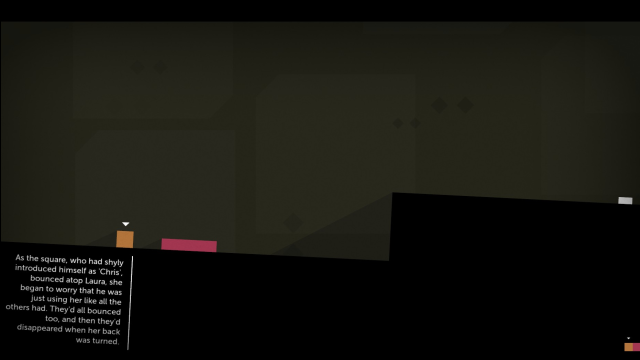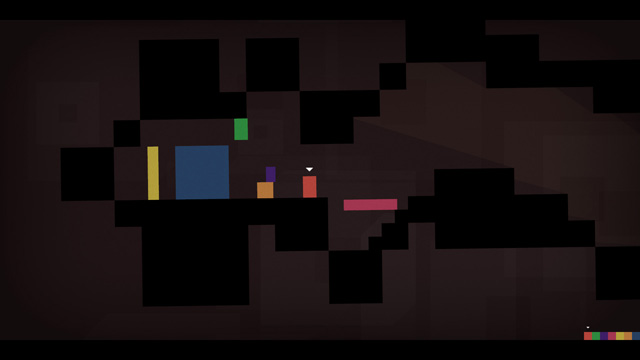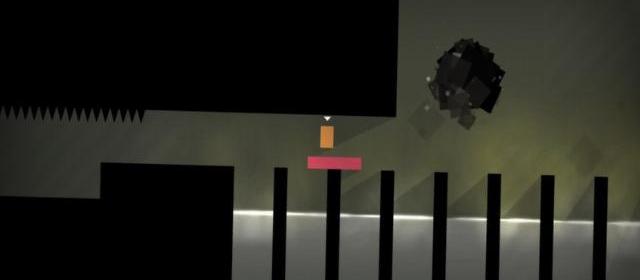With certain game designers touting the next generation’s polygonal count and realistic visuals as a way to elicit emotion from the player, it’s a marvel that UK games designer Mike Bithell can inject personality into a few squares and rectangles. Thomas Was Alone came to PC and Mac last year and now, with Sony’s push to get more indie developers on their platforms, Curve Studios and Bithell’s former employers Bossa Studios have handled the console port of the puzzle-platformer.
Initially a flash game that the Englishman created in a 24 hour game-jam, Thomas Was Alone was a labour of love for him as he worked on it whilst he was lead designer at social games dev Bossa Studios. The care and consideration with story is evident, yet the tasks these empathetic four-sided shapes encounter are, for the most part, just too easily overcome.
Over 100 levels, the player’s ultimate goal is to take a number of blocks to a highlighted destination on that particular stage. Of course, that’s breaking it down to the most simple of explanations. The first number of posed challenges are an introduction to the mechanics and the titular character, Thomas. Now, anyone that has played a 2D platformer will instantly understand the core principal behind the game – move left/right, jump every once in a while and get to your goal. As you progress, Thomas Was Alone opens up by introducing more characters with different traits such as higher jumps, double jumps and more.

At any one time, there can be a total of seven characters leaping, bouncing and navigating through the map. For all of the different characteristics of the individual polygons, the game does suffer once you have a full roster on-screen. Tediously going over old ground becomes an annoyance and hampers Bithell’s title in the run-up to the finish line. In levels where the count falls to a more workable number, these issues aren’t present – although, the entire game suffers because of over simplified resolutions. It’s very rare that the answer to a puzzle won’t grab you right away, and that only adds to the monotonous play of stages where there is an abundancy of anthropomorphic blocks.
But, that’s also where Thomas Was Alone excels. The personification of shapes is no easy task, yet throughout the whole tale, you begin to get attached to John, Claire, James, Sarah et al. They become real people, almost. With hang-ups, flaws and positives, a sense of warmth to Thomas’ friends (who just so happen to be faceless entities) is created via an expertly penned script. But, a script would be useless if the dialogue wasn’t delivered well and Danny Wallace turns out to be a perfect choice as narrator. Some may know him from his radio/TV broadcasting, but most gamers will be aware of Wallace’s tones as the rancid Shaun Hastings from Assassin’s Creed. Throw away any pre-conceived notions you have about the man, because his performance here is pitch-perfect.
Thomas Was Alone has a real sense of adventure. It’s a narrative built around forming unexpected bonds and performing feats of heroism most only dream of. The art compliments this notion as its minimalistic style makes the colourful troupe the focus of attention. Black platforms and blank backgrounds keep the main players’ relationships in the foreground – which is paramount. Another aspect that adds greatly to the narrative that Bithell is telling is the wonderful soundtrack created by young composer David Housden. There’s a reason why this was nominated for a BAFTA. Melding traditional elements such as strings and piano with a chiptune sound, Housden’s tracks not only add gravitas to proceedings, but also a sense of doubt and fear in the most appropriate of moments. Utter brilliance.
With this port, the changes are few, bar some notable improvements on Vita. With a few taps of the bumpers, players can cycle through on-screen characters and control whomever they desire, yet, at times, this can be a chore. Sony’s handheld offers that too, but does also allow players to use the touch screen in order to select any character whenever they wish. Another feature which doesn’t appear in many games, but is such a great addition, is the commentary option.

There are a spattering of video games here and there that will include designers mulling over their work whilst you play it, but with the amount of action in modern titles, a commentary is obviously a difficult thing to implement. However, with the stages in Thomas Was Alone lasting approximately a minute or two, this is achievable and it’s a real joy to hear Mike Bithell discuss design choices or character progression while you try to leap across the game world.
VERDICT: There are a number of defining factors as to why Thomas Was Alone will stay with you for quite some time after you complete it and sadly, challenge isn’t one of them. Most puzzles can tend to be too easy, with irritative instances occurring more as you progress. But, that’s not the takeaway, here. Thomas and co. are an endearing and vulnerable crew, and that all comes down to the terrific writing and the engaging delivery of the narration. Sure, Thomas Was Alone doesn’t re-tool a genre, but with understated art and a soundtrack that’s full of feeling, you’ll certainly find a place in your heart for the lonely quadrilateral.

EXCELLENT. An 8/10 is only awarded to a game we consider truly worthy of your hard-earned cash. This game is only held back by a smattering of minor or middling issues and comes highly recommended.






